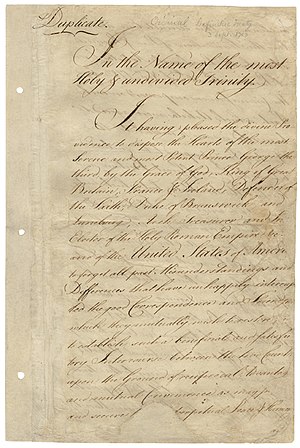
Back Vrede van Parys (1783) Afrikaans معاهدة باريس (1783) Arabic Paris sülh müqaviləsi (1783) Azerbaijani Париж килешеүе (1783) Bashkir Парыжскі мір (1783) Byelorussian Парижки договор (1783) Bulgarian Emglev Pariz (1783) Breton Tractat de París (1783) Catalan پەیماننامەی پاریس (١٧٨٣) CKB Pařížská smlouva (1783) Czech
| The Definitive Treaty of Peace Between the Kingdom of Great Britain and the United States of America | |
|---|---|
 The first page of the Treaty of Paris, signed on September 3, 1783 | |
| Drafted | November 30, 1782 |
| Signed | September 3, 1783 |
| Location | Paris, Kingdom of France |
| Effective | May 12, 1784 |
| Condition | Ratification by the Kingdom of Great Britain and the United States |
| Signatories | |
| Parties | |
| Depositary | United States government[1] |
| Language | English |
| Full text | |
The Treaty of Paris, signed in Paris by representatives of King George III of Great Britain and representatives of the United States on September 3, 1783, officially ended the American Revolutionary War and recognized the Thirteen Colonies, which had been part of colonial British America, to be free, sovereign and independent states.
The treaty set the boundaries between British North America, later called Canada, and the United States, on lines the British labeled as "exceedingly generous",[2] although exact boundary definitions in the far-northwest and to the south continued to be subject to some controversy. Details included fishing rights and restoration of property and prisoners of war.
This treaty and the separate peace treaties between Great Britain and the nations that supported the American cause, including France, Spain, and the Dutch Republic are known collectively as the Peace of Paris.[3][4] Only Article 1 of the treaty, which acknowledges the United States' existence as free, sovereign, and independent states, remains in force.[5]
- ^ Miller, Hunter (ed.). "British-American Diplomacy: Treaty of Paris". The Avalon Project at Yale Law School. Retrieved October 19, 2014.
- ^ Paterson, Thomas; Clifford, J. Garry; Maddock, Shane J. (January 1, 2014). American foreign relations: A history, to 1920. Vol. 1. Cengage Learning. p. 20. ISBN 978-1305172104.
- ^ Morris, Richard B. (1965). The Peacemakers: the Great Powers and American Independence. Harper and Row.
- ^ Black, Jeremy (April 14, 1994). British foreign policy in an age of revolutions, 1783–1793. Cambridge University Press. pp. 11–20. ISBN 978-0521466844.
- ^ "Treaties in Force A List of Treaties and Other International Agreements of the United States in Force on January 1, 2016" (PDF). United States Department of State. p. 477. Retrieved April 14, 2017.